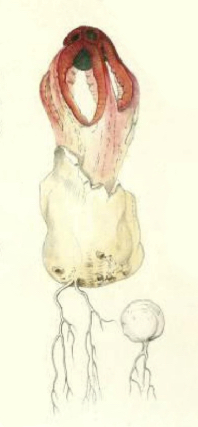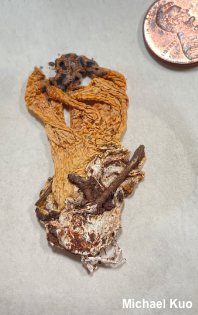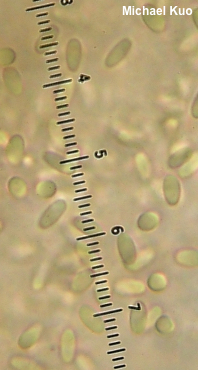| Major Groups > Stinkhorns > Colus hirudinosus |

|
Colus hirudinosus [ Agaricomycetes > Phallales > Clathraceae > Colus . . . ] by Michael Kuo This primarily Mediterranean stinkhorn features a cage-like structure above a stubby stem. The arrangement of the "cage" distinguishes it: 4–6 arms are fairly widely spaced for most of the cage—but at the top, an abrupt network of smaller spaces develops. Colus hirudinosus is similar to Oceania's Colus pusillus (and it may occur in Oceania as well, if online photos are accurate), but that species does not develop the abrupt network at the top, and is generally a bit larger and more red. As you can see from the illustrations, which represent a herbarium specimen and type illustrations from the 19th Century, I have not seen Colus hirudinosus in the fresh state. Have you collected it recently? I would love to study well-documented, preserved collections, in order to make this page more scientific. If you're interested in helping, please send me an email at . Clathrus hirudinosus is a synonym. Thanks to the Herbarium of the University of California, Berkeley for facilitating study of the Colus hirudinosus collection cited below. Description: Ecology: Saprobic; growing alone or gregariously; in woods or in cultivated areas; year-round; originally described from southern France; distributed around the Mediterranean in Europe, the Middle East, and northern Africa; reported from Jamaica. The collection studied is from Israel. Fruiting Body: Initially a whitish to brownish "egg" up to 1 cm across, attached to white cords; rupturing, with the stinkhorn emerging as a cage-like structure, 3–5 cm high and about 3 cm wide, composed of 4–6 corrugated arms that fuse into a stem-like base; arms widely spread until the apex; apex of the cage structure with an abrupt network of small openings; arms usually dark red, when fresh, near the apex—becoming paler (reddish orange, pink, pale orange) toward the base; the inner surfaces of the cage covered with foul-smelling, olive brown slime; the egg tissue creating a whitish volva at the base of the stinkhorn. Odor: Unpleasant and strong. Microscopic Features: Spores 3–5 x 1.5–2 µm; subcylindric; smooth; hyaline in KOH. Sphaerocysts of the pseudostipe 9–43 µm; subglobose, pyriform, or irregular; smooth; walls about 1 µm thick; hyaline to faintly yellowish in KOH. Hyphae of the volva 1–4 µm wide; smooth; occasionally branched; thin-walled; hyaline in KOH; septate; clamp connections not found. REFERENCES: A. Cavalier & P. Séchier, 1835. (Tulasne, 1849; Lloyd, 1907; Cunningham, 1931; Cunningham, 1944; Dring, 1964; Dring, 1980; Akata & Gürkanli, 2018.) Herb. UC 955042 (GenBank MK607412). This site contains no information about the edibility or toxicity of mushrooms. |
© MushroomExpert.Com |
|
Cite this page as: Kuo, M. (2022, February). Colus hirudinosus. Retrieved from the MushroomExpert.Com Web site: http://www.mushroomexpert.com/colus_hirudinosus.html |




